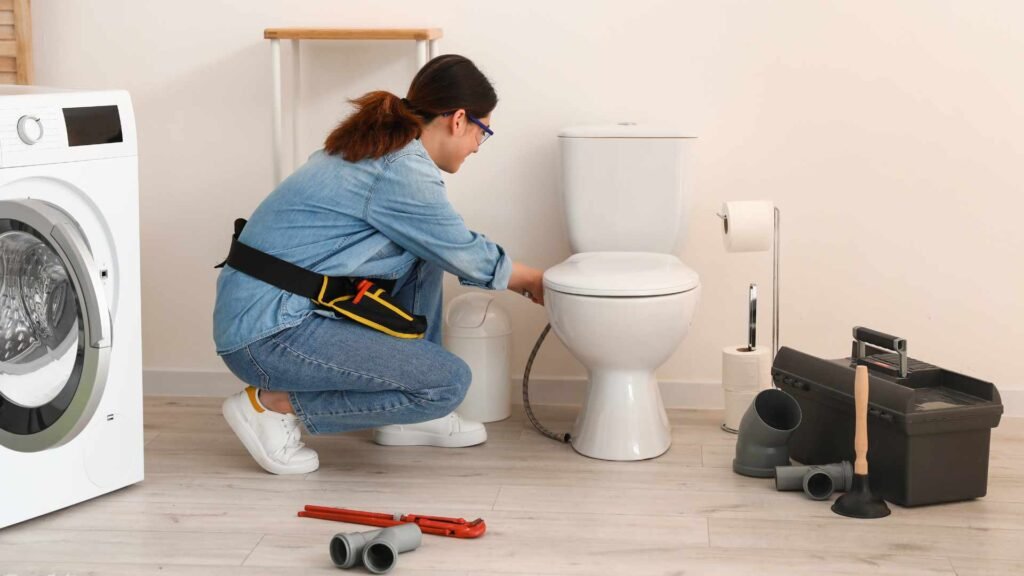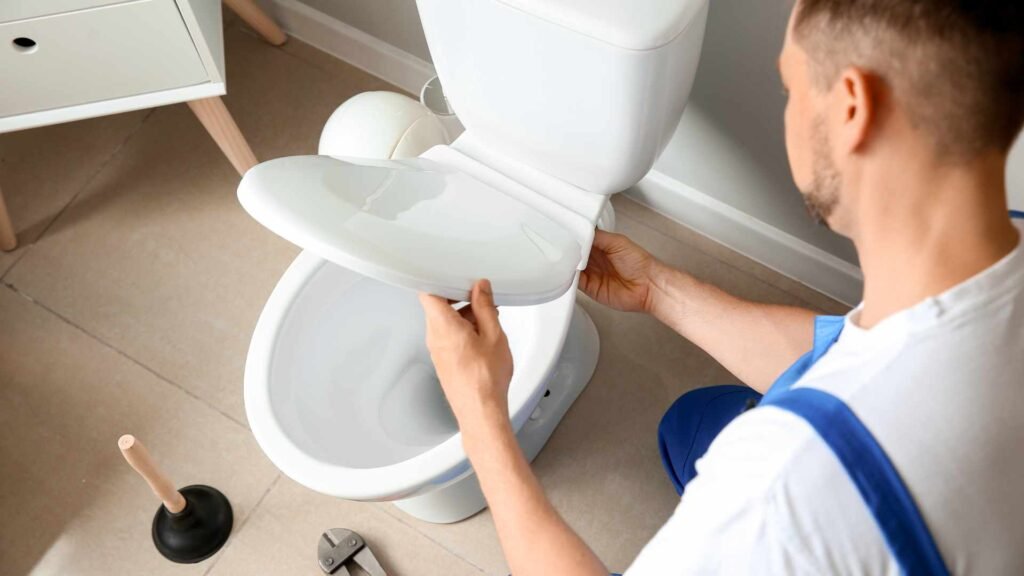Understanding the Basics of Bathroom Plumbing
Bathroom plumbing forms a foundational pillar in the comprehensive systems that operate within our homes, contributing directly to our everyday comfort and convenience. Its primary function revolves around the efficient delivery of water to various appliances such as showers, sinks, and toilets. Furthermore, it aids in the removal of waste and ensures a hygienic and sanitized environment. To comprehend this intricate system, one must recognize the two separate subsystems at work – the fresh water supply system and the drainage system. The fresh water supply system operates under pressure, propelling water to showers, sinks, and commodes on-demand and throughout the day. Conversely, the drainage system relies on gravity to guide waste and used water from the house to the sewer or septic system. Identifying and understanding these basic mechanisms can aid any homeowner in maintaining a well-functioning bathroom.
How to Choose the Right Commode for Your Bathroom
Delving into an array of lavatory models while planning a bathroom remodel can be an overwhelming task due to the vast variety of options available. Homeowners need to weigh multiple factors before settling on the perfect fixture for their personal comfort and style. These considerations include the size of the bathroom, the plumbing setting, the decor of the bathroom, environmental consciousness, and budget constraints. Each one plays a pivotal role in helping to decide the best-suited commode that harmoniously blends functionality with aesthetics.
Size is a predominant factor that often overshadows the most chic and stylish designs. Despite the lure of the advanced features, a commodious commode in a cramped space hampers mobility and disrupts the functionality of the bathroom. Compatibility with the existing plumbing set-up is similarly crucial to avoid unnecessary costly alterations. The design and aesthetic of the commode should reflect the overall decor in order to create a harmonious visual flow within the space. Water consumption and efficiency play a role in the sustainability of the design, while the budget ultimately affects the choice of make, model, and included features.

Give Us A Call Now At (855) 789-1250

Essential Tools Required for Lavatory Maintenance
Proper maintenance of a lavatory necessitates an assortment of crucial tools to ensure longevity and optimal operation. Familiarity with these instruments aids in comprehending their respective roles in different repair and maintenance tasks. The iconic tool of a plumber – the plumber’s wrench, commonly known as the pipe wrench, often proves invaluable in loosening or tightening fixtures. A plumber’s snake, or drain auger, comes into play when dealing with stubborn clogs that cannot be dealt with using a conventional plunger. The diversity in types of plungers, such as the common cup plunger and the more specialized flange plunger designed for toilets, further underlines their significance in lavatory maintenance duties.
Furthermore, having a set of screwdrivers of various sizes is a must for tasks such as tightening loose knobs or dismantling fixture parts. The use of channel locks, also known as slip-joint pliers, is commonplace for holding or turning pipes and fittings. For dealing with minor leaks or jobs related to the installation or removal of fixtures, materials like plumber’s tape and plumber’s putty tend to be extremely helpful. Lastly, the humble adjustable wrench is versatile and finds applicability in many smaller tasks. Having the right tools at one’s disposal can not only speed up repair work but also ensure that it’s undertaken with precision and effectiveness.
Unpacking Your New Lavatory: What to Expect
Upon receiving a new lavatory fixture, the first interaction begins with the unpacking process. Equipped with an inventory of parts and components, the fixture typically arrives in a carefully packed box, guarding against damage during transit. This box is specially designed to ensure that all elements, including the delicate porcelain parts as well as the small, yet crucial components, such as bolts and washers, arrive intact and ready for installation. Therefore, meticulousness is highlighted throughout this phase, starting from the moment the box is carefully opened to avoid any inadvertent harm to the packed items.
Once the outer packaging is removed, visual inspection of all components is advised. This includes examining the toilet bowl, tank and lid, along with all the connecting hardware provided. Special attention should be given to verify the presence of wax rings and mounting bolts, which are integral parts of the assembly process. All pieces, be it minute or major, should conform to the checklist garnered in the user manual to ensure a seamless assembling process. Thorough examination not only wards off potential difficulties during installation but also affirmatively signals commencement to the assembly phase.
Step-by-Step Guide to Assembling Your New Fixture
Upon purchasing a new lavatory fixture, it is essential to follow a systematic procedure during assembly to ensure a proper fit and avoid potential plumbing issues down the line. To begin the assembly process, one must first acquaint themselves with the manufacturer’s instruction manual. This manual will guide you through the process, providing clear instructions and diagrams for each step. It is crucial to cross-reference each packaged component with the parts list in the manual; doing so will ensure that you have all necessary components before commencing the assembly.
Once a thorough inventory has been completed, the base of the fixture should be secured first. Typically, this involves aligning the fixture’s base with the pre-existing plumbing connections in your bathroom. It’s important to have the right tools at hand, including adjustable wrenches and Teflon tape for securing pipe connections. Next step usually involves installing the tank, the lid, and the toilet seat if dealing with a commode. Each of these steps proves integral to the final assembly and requires careful attention to detail to ensure a secure and leak-free installation.

Troubleshooting Common Lavatory Problems
Being familiar with common issues that can arise in bathroom plumbing is crucial in maintaining a fully-functional, hassle-free lavatory environment. One prevalent issue that users often encounter is a running toilet. This problem is typically attributed to a malfunctioning flapper or a fill valve that doesn’t effectively stop the flow of water. Quick attention to such matters is pertinent to avoid wastage of water and to keep one’s utility bills under control.
Blockages are another widespread concern in bathroom plumbing. These occur when the drain gets choked up due to substances like soap, hair, and other debris. In such scenarios, the sink or shower drain experiences slower drainage than usual. In the worst-case scenario, if left untreated, this could lead to backups or even bursting of pipes, leading to significant damage. Hence, a basic understanding of these common problems can prove to be really beneficial in maintaining an efficient plumbing system.
Give Us A Call Now At (855) 789-1250
Simple Fixes for Common Commode Issues
Slow or clogged drains are one of the most typical issues encountered with commodes. The reason for the obstruction can usually be traced back to the accumulation of everyday objects like tissue, paper towels, hair or fats. A plunger is often sufficient for dislodging these blockages. Care should be taken to create a good seal over the drain; this enhances pressure and effectiveness. Remember to use a steady, strong pulsing action to shift the impediment. Manual drain snakes can also be used for more stubborn clogs by inserting into the pipe and rotating to break up the obstruction. Another common concern with commodes is a continually running toilet, which can be attributed to issues within the tank. This is often a sign of a problematic flapper seal, fill valve, or overflow pipe. By removing the lid of the tank and doing a basic evaluation, the root cause of the issue can be discerned. One can listen for any water flowing into the overflow pipe, check the fill valve for any potential blockages and inspect the integrity of the flapper seal. Most of these components are easily replaceable and can be found in any standard home improvement store. Ensuring the correct fit and size of the replacement parts is crucial to maintaining the functionality of the commode.

Frequently Asked Questions
Bathroom plumbing involves various elements such as the drainage system, water supply lines, and vent pipes, all that are key components in the efficient working of your lavatory.
Multiple factors come into play while choosing a commode for your bathroom. These can include the size of your bathroom, the type of flush system you prefer, the style and design that suits your decor, and your budget.
Some of the essential tools required for lavatory maintenance include a plunger, pipe wrench, drain snake, and plumber’s tape. Each tool has a specific role in maintaining the optimal functioning of your lavatory.
When unpacking your new lavatory, you should expect to find all the necessary components like the bowl, tank, seat, and the required hardware for assembly. You should also look for an instruction manual that will guide you through installation.
While it may vary with different models and brands, a basic step-by-step guide would involve installing the bowl, securing the tank, attaching the seat, and setting up the water connections. Always refer to your instruction manual for specific steps.
Common lavatory issues can range from clogged drains and leaking faucets to running toilets and low water pressure.
Yes, there are simple fixes for some common commode issues. For instance, a plunger can usually unclog a blocked toilet, and a leaking faucet might need a replacement washer.
You should call a professional for lavatory maintenance when you encounter complex issues such as persistent leaks, major blockages, low water pressure, or when you need to install a new fixture. If you’re uncertain about a problem or if your attempts to fix it haven’t worked, it’s best to call a professional.
When to Call a Professional for Lavatory Maintenance
While it’s true that many bathroom or lavatory maintenance tasks can be accomplished with a little DIY knowledge and some basic tools, there are certain scenarios where the skills and expertise of a professional plumber become indispensable. Dealing with intricate plumbing systems can often become complex and if not handled with precision, can even lead to significant water damage, costly repairs, and prolonged inconveniences. Therefore, understanding when to consult with a professional is crucial to ensure a smoothly functioning bathroom and to preserve the longevity of the plumbing infrastructure. Plumbing emergencies such as severe leakage, low water pressure, or blocked pipes often require immediate attention from seasoned professionals. Specialized equipment and techniques are required for proper diagnosis and remediation of these issues. Moreover, when it comes to installation of new fixtures or replacement of old, corroded pipes, a professional touch ensures correct fitting, adherence to local building codes, and safeguards your warranty arrangements. This expertise in handling complex tasks and prompt response in times of emergency sets professional plumbing services as a vital requirement in maintaining and improving bathroom efficiency.
To get a quote call Mr Plumbing Inc now
